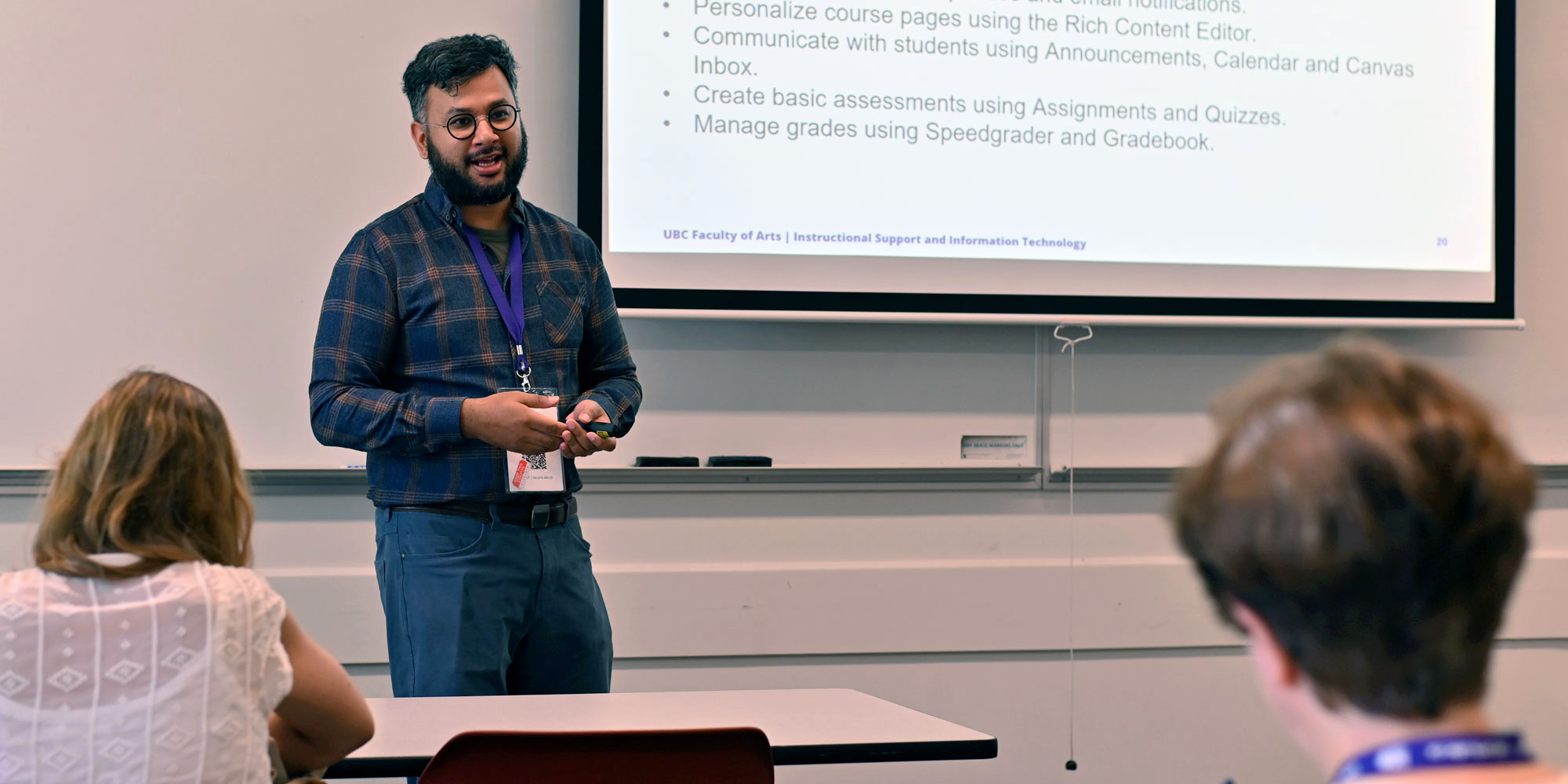

Dr. Patrick Parra Pennefather, Assistant Professor at UBC Theatre and Film
In THTR 308, a Sound Design course, students learn about different considerations when it comes to the design of sound for live or virtual productions.
The instructor facilitates a learning environment where students are provided tools, direction, and practice to understand the various characteristics that contribute towards designing sound for different media. In MDIA 470, a course deeply embedded within the Emerging Media Lab (EML) at UBC, the learning outcomes have been developed based on competencies that are expected of students when they graduate and work collaboratively with others to develop technology. Students are expected to learn how to work collaboratively, apply appropriate methodologies, problem solve, and ultimately create some type of workable prototype using Virtual Reality (VR) or another medium.
“Practical learning for me is engaging in the practice of applying craft, technique and skill to projects that are intended to improve specific competencies. Those competencies are connected to collaborating, communicating, problem-solving, developing criticality and managing creativity with others over time.”
Both THTR 308 and MDIA 470 engage students to apply design thinking and explore different tools and methodologies for problem-solving, and eventually develop the necessary competencies, capacities, and resilience to eventually transition into communities of practice when they graduate.
- Develop students’ abilities to apply design thinking skills to the needs of a real-world problem, context and audience
- Provide opportunities for students to engage with each other so that they can become familiar with the skills, knowledge and attributes needed from each team member to successfully work collaboratively
- Encourage students, as they are all equally responsible towards their learning, to advocate for themselves by determining class development and evolution together with the instructor and peers, and accept that an idea contributed by them is equal to any other contribution, including that of the instructor
- Provide opportunities for students to reflect on their own willingness to learn and develop competencies along with regular reflection on project development
- Allow students to become aware of their own heuristics or their own rules of play so that they overcome barriers to identifying root causes of problems, and be ready to continuously iterate and improve solutions or prototypes
Learning Activities
Delivery
Lecture
Method
Via weekly short interactive lecture topics, brainstorming activities, and discussions, students take part in the following activities:
- Prepare students for the course by discussing development of the class lectures and activities by using some brainstorming tools and visual tools such as MIRO, and collaboratively determining course content, assignments, and course direction. Developing core values and rules of play for their interactions with one another is also an essential starting point for every course.
- Students begin by learning basic design thinking skills that focus them on human-centered design and the building of an aligned team culture. In THTR 308, simple design thinking activities engage students in coming up with a system for their behavior with each other, towards course content, and towards the overall teaching and learning environment. In MDIA 470, students engage in human-centered design techniques, such as Persona and other psycho demographic tools, to create user or customer journeys, and use storyboarding as a tool.
- Students partake in activities that allow them to experience what it is like to collaborate together on something, and that activity can be as simple as passing a ball around in a circle. In this activity the students work in teams to find ways to pass the given ball within their teams within the given time such as 45 seconds. With every round that the teams successfully complete, the stakes keep rising as the given time keeps reducing. The students think together and come up with ways to beat the clock, sometimes by creatively interpreting the rules and sometimes by bending them.
- Students reflect and self-reflect at multiple stages: when developing a piece of emerging technology, the instructor plans a series of activities once students identify a problem, where they self-reflect to determine the skill sets of the team members, and assess their own willingness to learn new skills that may be required for the project. Students are expected to rationally plot out what they are able to do over short periods of time, and can learn to use Agile to scope out what they can achieve during the course in terms of development of their project. Students are assigned targeted reflection activities weekly so that students’ knowledge of co-constructing a project together is scaffolded over time.
- Students explore root cause visual models to get to the root of the problem that they are trying to solve (students often find this activity challenging). The activity can be enhanced with an LLM like Chat GPT-4 to reinforce that there may be several roots of a problem.
- To create emerging technology, students must become comfortable with the need to iterate and improve upon their project. Thus, students learn to prototype throughout the course, creating versions of something in process until ultimately creating a set of low fidelity prototypes.
Grading
- Students are given feedback based on their contribution to class discussions and how well they follow instructions or provide reflections.
- Students are required to complete weekly reflective activities and occasional peer assessments. The instructor assesses the accuracy of these self-assessments and can also provide feedback to help students re-evaluate their self-assessment if they have been hypercritical of themselves contrary to the opinion of their teammates.
- Overall, the instructor grades are based on iterative assessment: a rubric of specific competencies (for example, potential to communicate with others and the evidence of that communication) is available for every assignment and students have the opportunity to improve and resubmit for every submission except for the final project.
What did students share about their experience with the Practical Learning activities?
There are varying degrees of learner-responses and outcomes in all project-based courses that I teach. Many are not familiar with developing the design skills and competencies they experience, and less are used to working with others. However, towards the conclusion of the course, most students are satisfied, and some, more than others, have embodied a way of creating work that is going to have lasting resonance. They learn to how to collaborate, and also learn about their affinity towards this way of working, which is an important outcome of the course. Most of the comments about the course reflect that students consider the experience of co-constructing something with others valuable, they have increased their skills, and they have better understood what they may need to learn to be successful in a particular industry.
Student responses to learning in this way fall within various fluid categories:
- Initial resistance and confusion to some course content, assignments, and course direction
- Habitual learning pattern of needing to be told what to do
- Understanding that learning can also be fun and openness to learning from others
- Lack of experience in documenting self-reflection
- Giving and listening to feedback from their peers
- Slow acceptance of their own creative competencies
- Managing communication in team-based work over time
- Becoming aware of their own heuristics or their own rules of play around identifying and solving problems
- Radical transformation of how they learn that influences the remainder of their learning journey
What are some changes or improvements which you wish to include in future?
Availability of computing resources for students is a persistent problem. I think that these resources are necessary for students, and I need more of those for my students, so I am always trying to find funding or partnerships within the university and externally. I also want more time with students, more than a 3-credit course. I have taught 12-credit courses in a single semester at another university, which are intense and beneficial to students, helping them grow quicker. More time to engage with content and to work with and learn from one another would support and reinforce competencies associated with the course.
Do you have any suggestions for instructors considering this Practical Learning for their course?
Anyone who teaches project-based courses should have the commitment to learn and to facilitate others to learn. You need to be actively interested in the community of practice associated with what you are teaching. If I am teaching about VR, I need to understand what the latest tools are and keep up with the technology. You also need to maintain a connection to that industry to be able to invite them to teach. Many of my students are embedded in the digital media industry who I bring into my classes. They have more specific and direct knowledge, and insights which I would not possibly have. It is important to give students this exposure.
Instructors need to understand that a project-based course will shift, change, and need to adapt to the unique characteristics of learners in the course. An openness to shifting direction, slowing down, accelerating sometimes, going beyond what is written in a course outline is essential, so is communicating at the beginning of the course that that may happen. In addition:
- Being reflective at the end of each course
- Facilitating learning vs trying hard to teach students something.
- Learning from teaching
- Seeing each learner that you teach as someone who comes to your class with knowledge
- Respecting differences in learning and affirming those differences
- Facilitating learners to participate in the co-creation of class values and rules of play during the first class that will govern how learners interact with one another and course content.
- Being clear how learners will be assessed and drawing from the rich history of project-based learning to identify competencies that can be assessed and how students can demonstrate these.
- Involve students in providing you persistent feedback so that you too can improve your offering to them
Do you wish to share anything further?
I am passionate about this kind of learning and there are so many benefits. I would just encourage those who are considering it that it is a rewarding path to go down. The best thing to do is to try it to see if it works for you. If anyone wants to learn more about my methodological approach to designing project-based interactions informed by social constructivism, I have recently published a book called Mentoring Digital Media Projects.
Practical Learning with Dr. Patrick Pennefather- Q&A
Level of Difficulty: High
Delivery: Lecture
Course:THTR 308 (“Sound Design”) and MDIA 470 (“Special Topics”)
Number of Students: Small to medium lectures with 35 to 140 students
Expected Prep Work: Medium
Time: 1 full course length
Keywords: design thinking, emerging technology, collaboration


